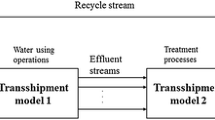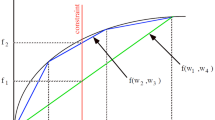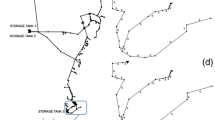Abstract
This paper presents a methodology for the optimal synthesis of distributed treatment systems of effluents discharged into a main river to meet water discharge quality constraints. The methodology is based on a new superstructure that is formulated and solved as a multi-objective mixed-integer nonlinear programming model. A material flow analysis technique is used to track the pollutants through the watershed considering the combined effects of the inputs, outputs (i.e., agricultural, residential, industrial, and so on) and the chemical transformations. A disjunctive programming model is implemented for selecting the optimal location of the distributed treatment system. Prior to the optimization and based on the pollutants considered, a discretization approach is implemented to determine from simulation the removal efficiency and the unit cost of given configurations and operating conditions of the selected treatment units. Therefore, the optimization process determines the removal efficiency used to treat the effluents and the flow rate treated. Simultaneous minimization of the total annual cost of the distributed treatment system and the contaminant concentration of the discharge to the catchment of the watershed are considered as two objective functions. Three case studies (one in Mexico and two in Egypt) have been selected to illustrate the methodology. Results show that significant savings can be obtained when the distributed treatment system is implemented. Finally, the proposed methodology can be used for supporting governmental decisions (i.e., it provides the investment required for a specific water quality).










Similar content being viewed by others

Abbreviations
- A i,j :
-
Area covered by effluent j in reach i (acre or ha)
- CD i,j :
-
Concentration of agricultural discharges to the tributary j to the reach i (ppm)
- CIND i,j :
-
Concentration of industrial discharge from the tributary i to the reach i (ppm)
- CL i :
-
Concentration of total losses (filtration and evaporation) from the reach i (ppm)
- CL i,j :
-
Concentration of total losses (filtration and evaporation) from tributary j (ppm)
- CP i,j :
-
Concentration of precipitation discharged to the tributary j to the reach i (ppm)
- CQ i :
-
Concentration of flow rate exit from the reach i (ppm)
- CQ desired n(i) :
-
Limit for the desired concentration in some reaches
- CQdis :
-
Pollutant concentration for the final disposal (ppm)
- CQ i−1 :
-
Concentration of flow rate inlet to the reach i (ppm)
- CS untreated i,j :
-
Concentration of residual wastewater discharged without treatment to the reach i for tributary j (ppm)
- CS treated i,j :
-
Concentration of residual treated wastewater discharged to the reach i for tributary j (ppm)
- CT i,j :
-
Concentration of discharge for the tributary j to the reach i (ppm)
- CU i :
-
Concentration of water used from reaches i (ppm)
- CU i,j :
-
Concentration of water used from tributary j discharge to reach i (ppm)
- D i :
-
Direct discharges to the reach i (m3/s)
- D i,j :
-
Agricultural discharges to the tributary j to the reach i (m3/s)
- FC:
-
Fixed cost for interceptor x ($)
- fs x :
-
Segregated flow rate from the wastewater of the tributary to the interceptor x
- H i :
-
Total discharge (i.e., industrial + sanitary) to the reach r (m3/s)
- H Y :
-
Operation time per year (h/year)
- I :
-
Set for the reaches
- IND i,j :
-
Industrial discharge from the tributary j to the reach i (m3/s)
- J :
-
Set for the tributaries
- k :
-
Kinetic constant for the degradation of the pollutant in the system
- k f :
-
Factor used to annualize the capital costs (year−1)
- L :
-
Set for the components
- L i,j :
-
Total losses (filtration and evaporation) from tributary j (m3/s)
- L i :
-
Total losses (filtration and evaporation) from the reach i (m3/s)
- N i :
-
Total number of reaches
- N(I):
-
Subset for specific reaches that require composition constraints
- P i :
-
Precipitation discharged to the reach i (m3/s)
- P i,j :
-
Precipitation discharged for the tributary j to the reach i (m3/s)
- Q i :
-
Exit flow rate from the reach i (m3/s)
- Q i−1 :
-
Inlet flow rate to the reach i (m3/s)
- r i :
-
Reaction carried out in the reach i
- r i,j :
-
Reaction carried out in the tributary j that discharges to the reach i
- S untreated i,j :
-
Residual wastewater discharged without treatment to the reach i from tributary j (m3/s)
- S treated i,j :
-
Residual treated wastewater discharged to the reach i for tributary j (m3/s)
- T i,j :
-
Discharge for the tributary j to the reach i (m3/s)
- TAC:
-
Total annual cost ($/year)
- U i,j :
-
Water used from tributary j discharged to reach i (m3/s)
- U i :
-
Water used from reach i (m3/s)
- V i :
-
Volume for reach i (m3)
- V i,j :
-
Volume for tributary j discharged to reach i (m3)
- VCγ :
-
Variable cost for interceptor x ($/m3)
- X :
-
Set for the interceptors
- y i,j :
-
Binary variable associated to the existence of the treatment plant
- z x :
-
Binary variable associated to the existence of the interceptor x
- λ i,j :
-
Agricultural flow rate per area (m3/ha s)
- α :
-
Efficiency factor to remove the pollutant for the interceptor j
- β i,j :
-
Agricultural use of water from tributary i (m3/ha s)
- Ω :
-
Small number
- i :
-
Reach
- j :
-
Tributary
- l :
-
Number of components
- n(i):
-
Reaches that requires a composition constraint
- x :
-
Interceptor
References
Alva-Argaez A, Kokossis AC, Smith R (1998) Wastewater minimization of industrial systems using an integrated approach. Comput Chem Eng 22:S741–S744
Alva-Argaez A, Vallianatos A, Kokossis A (1999) A multi-contaminant transshipment model for mass exchange networks and wastewater minimization problems. Comput Chem Eng 23:1439–1453
Baccini P, Brunner P (1991) Metabolism of the anthroposphere. Springer-Verlag, Berlin
Benko N, Rev E, Fonyo Z (2000) The use of nonlinear programming to optimal water allocation. Chem Eng Commun 178:67–101
Best G, Niemirycz E, Bogacka T (1998) International river water quality: pollution and restoration. Spon Press, London
Brooke A, Kendrick D, Meeruas A, Raman R (2006) GAMS-language guide. GAMS Developed Corporation, Washington, DC
CONAGUA (2008) Mexican national water commission-water statistics. http://www.conagua.gob.mx/OCB07/Temas/EstadisticasBALSAS-FINALago09.pdf. Accessed October 2010
CONAGUA (2009) Mexican national water commission-water atlas in Mexico. http://www.conagua.gob.mx/CONAGUA07/Publicaciones/Publicaciones/SGP-18-11.pdf. Accessed October 2010
Cooper B (1986) Developing management guidelines for river nitrogenous oxygen demand. J Water Pollut Control Fed 58:845–852
Doyle SJ, Smith R (1997) Targeting water reuse with multiple contaminants. Process Saf Environ Prot 75:181–189
Drolc A, Zagorc-Koncan J (1996) Water quality modeling of the river Sava. Slovenia Water Res 30:2587–2592
Drolc A, Zagorc-Koncan J (2002) Estimation of source of total phosphorus in a river basin and assessment of alternatives for river pollution reduction. Environ Int 28:393–400
El-Baz AA, Ewida KT, Shouman MA, El-Halwagi MM (2005a) Material flow analysis and integration of watersheds and drainage systems: I. Simulation and application to ammonium management in Bahr El-Baqar drainage system. Clean Technol Environ Policy 7:51–61
El-Baz AA, Ewida KT, Shouman MA, El-Halwagi MM (2005b) Material flow analysis and integration of watersheds and drain systems: II. Integration and solution strategies with application to ammonium management in Bahr El-Baqar drain system. Clean Technol Environ Policy 7:78–86
Gabriel FB, El-Halwagi MM (2005) Simultaneous synthesis of waste interception and material reuse networks: problem reformulation for global optimization. Environ Prog 24:171–180
Galan B, Grossmann IE (1998) Optimal design of distributed wastewater treatment networks. Ind Eng Chem Res 37:4036–4048
Gunaratnam M, Alva-Argaez A, Kokossis A, Kim JK, Smith R (2005) Automated design of total water systems. Ind Eng Chem Res 44:588–599
Haimes YY, Lasdon LS, Wismer DA (1971) On a bicriterion formulation of the problems of integrated system identification and system optimization. IEEE Trans Syst Man Cybern 1:296–297
Hernandez-Suarez R, Castellanos-Fernandez J, Zamora JM (2004) Superstructure decomposition and parametric optimization approach for the synthesis of distributed wastewater treatment networks. Ind Eng Chem Res 43:2175–2191
Karuppiah R, Grossmann IE (2006) Global optimization for the synthesis of integrated water systems in chemical processes. Comput Chem Eng 30:650–673
Kennish MJ (1999) Estuary restoration and maintenance. CRC Press, Boca Raton
KuoW CJ, Smith R (1997) Effluent treatment system design. Chem Eng Sci 52:4273–4290
Lampert C, Brunner PH (1999) Material accounting as a policy tool for nutrient management in the Danube Basin. Water Sci Technol 40:43–49
Lovelady EM, El-Baz AA, El-Monayeri D, EL-Halwagi MM et al (2009) Reverse problem formulation for integrating process discharges with watersheds and drainage systems: managing phosphorus in lake Manzala. J Ind Ecol 13:914–927
Nápoles-Rivera F, Ponce-Ortega JM, El-Halwagi MM, Jiménez-Gutiérrez A (2010) Global optimization of mass and property integration networks with in-plant property interceptors. Chem Eng Sci 65:4363–4377
Ng DKS, Foo DCY, Tan R (2009) Automated targeting technique for single-impurity resource conservation networks. Part 2: single-pass and partition waste-interception systems. Ind Eng Chem Res 48:7647–7661
Ponce-Ortega JM, Serna-González M, Jiménez-Gutiérrez A (2009a) A disjunctive programming model for simultaneous synthesis and detailed design of cooling networks. Ind Eng Chem Res 48:2991–3003
Ponce-Ortega JM, Hortua AC, El-Halwagi MM, Jiménez-Gutiérrez A (2009b) A property-based optimization of direct recycle networks and wastewater treatment processes. AIChE J 55:2329–2344
Ponce-Ortega JM, El-Halwagi MM, Jiménez-Gutiérrez A (2010) Global optimization of property-based recycle and reuse networks including environmental constraints. Comput Chem Eng 34:318–330
Ponce-Ortega JM, Mosqueda-Jiménez FW, Serna-González M, Jiménez-Gutiérrez A, El-Halwagi MM (2011) A property-based approach to the synthesis of material conservation networks with economic an environmental objectives. AIChE J 57:2369–2387
Putra ZA, Amminudin KA (2008) Two-step optimization approach for design a total water system. Ind Eng Chem Res 47:6045–6057
Raman R, Grossmann IE (1994) Modeling and computational techniques for logic based integer programming. Comput Chem Eng 18:563–578
Savelski MJ, Bagajewicz MJ (2000) On the optimality conditions of water utilization systems in process plants with single contaminants. Chem Eng Sci 55:5035–5048
Savelski MJ, Bagajewicz MJ (2001) Algorithmic procedure to design water utilization systems featuring a single contaminant in process plants. Chem Eng Sci 56:1897–1911
Savelski M, Bagajewicz M (2003) On the necessary conditions of optimality of water utilization systems in process plants with multiple contaminants. Chem Eng Sci 58:5349–5362
Teles J, Castro PM, Novals AQ (2008) LP-based solution strategies for the optimal design of industrial water networks with multiple contaminants. Chem Eng Sci 63:376–394
Viswanathan J, Grossmann IE (1990) A combined penalty function and outer approximation method for MINLP optimization. Comput Chem Eng 14:769–782
Wang YP, Smith R (1994) Wastewater minimization. Chem Eng Sci 49:981–1006
Author information
Authors and Affiliations
Corresponding author
Rights and permissions
About this article
Cite this article
Burgara-Montero, O., Ponce-Ortega, J.M., Serna-González, M. et al. Optimal design of distributed treatment systems for the effluents discharged to the rivers. Clean Techn Environ Policy 14, 925–942 (2012). https://doi.org/10.1007/s10098-012-0469-2
Received:
Accepted:
Published:
Issue Date:
DOI: https://doi.org/10.1007/s10098-012-0469-2



